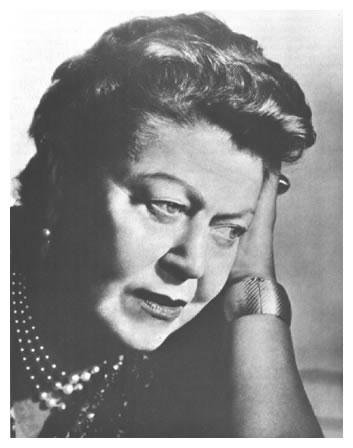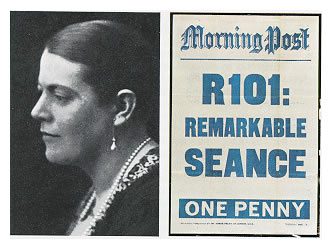Eileen J. Garrett
(1893 to 1970)

Eileen J. Garrett is, perhaps, the most respected medium of the twentieth century. Her contributions to the investigation and understanding of mediumship and allied phenomena remain immeasurable.
As a sensitive, she was very much aware of people’s moods and feelings. As a psychic researcher, she recognized the need for a scientific and an open-minded investigation of paranormal phenomena. As an author, lecturer, and publisher, she sought to share her ideas and experiences with the public. As an administrator, she had a keen mind and a sense of perception for the more mundane aspects of life.
Any one of these undertakings would certainly be a career in itself, but there was something quite remarkable about this woman which allowed her to pursue all four with amazing zest, integrity, and effectiveness.
Eileen Garrett was born in 1893, in Beauparc, County Meath, Ireland. From the beginning, her life was riddled with tragedy. Her parents both committed suicide shortly after her birth; she was then adopted by an aunt and uncle. In her autobiography, she writes:
“Once I heard my aunt refer to them as ‘poor Anthony and Anna’ in a tone that held both pity and disapproval, and a sympathy for them stirred within me . . . It was explained to me later that Anna and Anthony were my dead parents. I was glad then that I had given their names to many living things that I had cherished.”
Psychic experiences were part of Eileen Garrett’s life from the moment she saw an infant for the first time. She sensed and saw around people, animals, and plants various forms of light and energy which she initially termed “surrounds”. She had imaginary playmates, something to which many of us can relate, whom she called “the children”. She claimed that their appearance was a normal part of her life and that she “did not have to go to them in any particular place, or make any adjustments” in order to see them.
One day, while quite young, she saw her favorite aunt, who lived about twenty miles away, walking up the path carrying a baby. As the aunt approached, she said to young Eileen, “I am going away now, and I must take the baby with me.” Eileen quickly ran into the house to relate this to her adoptive aunt, who immediately punished her for making up stories. The following day she learned that her aunt Leone had died in childbirth, along with the baby.
This unfortunate introduction to death had its impact upon young Eileen. She had many questions concerning birth and death, none of which anyone, least of all her aunt, cared to discuss with her. As a means of protest, and in response to some undeserved punishment, she drowned some ducklings of which her aunt was very proud. She recalls, “The little dead bodies were quiet, but a strange movement was occurring all about them. A gray, smoke-like substance rose up from each small form. This nebulous, fluid stuff wove and curled as it rose in winding spiral curves, and I saw it take new shape as it moved out and away from the quiet forms.” Thus, she became aware, at a young age, that there was more to life than the physical form, and that this “more” separated itself from the body at the time of death.
Illness plagued Eileen Garrett’s younger years. Tuberculosis and other respiratory conditions flared up frequently and, at age fifteen, she left Ireland for the milder climate of England. She stayed in England with relatives and, soon thereafter, was courted by an older gentleman named Clive, whom she married within a few months. She gave birth to three sons, all of whom died at early ages. The eldest and second-born sons both died of meningitis within weeks of each other. The third died a few hours after birth. Eventually, she gave birth to her daughter, Eileen. Once again, her health deteriorated and, by the time she recovered, her marriage had ended in divorce.
During World War I, she opened a hostel for convalescent soldiers. It was during this period that she met and married her second husband, a young officer who was immediately called to the front. She had a premonition that this marriage would be short-lived. In her memoirs she wrote:
“I knew that my young husband was . . . suffering. In order to find release from the depression . . . I gathered several friends together and went out to dine. That evening . . . I had a vision of my husband, dying.”
Two days later, he was listed as missing in action and, shortly thereafter, he was listed as having been killed in Ypres.
Again, she fell ill and, while recuperating, she became friendly with a young man whom she eventually married. She readily admits, “I drifted into my third marriage without any thought of its being permanent.” It was at about this time that Mrs. Garrett began investigating psychic matters. Despite all this unhappiness and tragedy, she was being prepared for her major role in life: that of a sensitive.
One day, during a table rapping session, she became drowsy and started falling asleep. When she awakened, she discovered that dead relatives of others in the room had communicated through her. In spite of her husband’s warnings never to attend such meetings again, she sought the advice of one Mr. Huhnli who took it upon himself to guide Eileen in her understanding of what was happening to her. At one such meeting, she was entranced by an Arab soldier called Uvani who expressed his interest in helping prove survival.
Mrs. Garrett’s mediumship had finally come to the surface, but fear, ill health, and the break-up of her marriage delayed its development. Despite this delay, she eventually came to meet J. Hewat McKenzie, founder of the British College of Psychic Science. It was under his careful guidance at the College that her mediumship blossomed. Mr. McKenzie and his wife, Barbara, were keenly aware of the need for mediumship to expand well beyond that of messages from the spirits. They recognized that mediumship could provide a tool whereby the investigator could delve into the various dimensions and levels of perception and consciousness. Mr. McKenzie was probably the most powerful influence upon Eileen Garrett, as well as her attitudes concerning the process of communication. She continued studying and developing her mediumship at the College until Hewat McKenzie’s death in 1929.
Marriage was once again in the offing and, once again, after a premonition, it ended in tragedy. Both she and her fiancé became ill on the same day. He died of pneumonia, and she barely survived a mastoid operation. Confused about what to do, convinced that her mediumship resulted from nothing more than a split personality, and quite fed up with the Spiritualist “message game”, she decided to come to the United States and seek help from the scientific community.
In the United States, she was able to make connections with many noted scientists and parapsychologists. She subjected herself to intense physiological and psychological experimentation, hoping that such testing might shed light upon the processes of mediumship and psychism. She traveled to and from the States, searching, studying, and experimenting.
When the Second World War broke out in Europe, she was in France working with children and refugees. She remained there until the end of 1940, when, in a “wholly spontaneous and of external origin” flash, she knew she should leave and seek other work. Quite miraculously, she arrived at Lisbon and found passage on a refugee boat to New York.
Her life now took a definitive course. Within a few months of her arrival in New York, she started Tomorrow, a monthly magazine of literary and public affairs. She also started the publishing firm, Creative Age Press.

Eileen Garrett’s greatest achievement was the founding of the Parapsychology Foundation, in 1951. Her honesty and acumen for business affairs helped make this one of today’s most respected foundations of its type. Over the years, the Parapsychology Foundation has published several fine journals, newsletters, and reports, many under the presidency of Mrs. Garrett herself. In the autumn of 1952, Tomorrow was re-instituted as a quarterly journal for the study of psychic science. In January, 1955, the Foundation began publishing its bimonthly newsletter, followed, in 1958, by a series of Parapsychological Monographs, and, in 1959, by the very prestigious International Journal of Parapsychology. In March, 1970, the Foundation began publishing the Parapsychology Review, a bimonthly review of articles, news, and books. Unfortunately, the Parapsychology Review suspended publication a few years ago. The Parapsychology Foundation has hosted twenty-eight Annual International Conferences on parapsychology and allied sciences.
Eileen Garrett had four trance communicators. Uvani, a fourteenth century Arab soldier, was the control of the mediumship. Abdul Latif, a seventeenth century Persian physician, dealt primarily with healing. Speaking seldomly and on more philosophic and spiritual matters, were Tahotah and Ramah. These two claimed no earthy incarnations.
One of Eileen Garrett’s more memorable communications, as a medium, was the case of the R101. Here is what Nandor Fodor says about this in his Encyclopedia of Psychic Science:
“In a sitting at the National Laboratory of Psychical Research on October 7, 1930, two days after the explosion of the R101, Flight Lieutenant H. C. Irwin, Captain of the airship, suddenly entranced Mrs. Garrett, announced his presence and gave the listeners a highly technical account of how the airship crashed. The narrative was taken down in shorthand and a copy was submitted to the Air Ministry. According to the opinion of experts, a number of observations in the message tallied in every detail with what was afterwards found in the course of the official inquiry. E. F. Spanner, the well-known naval architect and marine engineer, came to exactly the same conclusions in his book, The Tragedy of the R101.”
Despite the wealth of information and evidence of survival which came through Eileen Garrett, she was never quite convinced that her mediumship stemmed from a separate source; an attitude which, in our opinion, made her mediumship so profoundly wonderful. She was always searching for more information concerning the secrets behind the consciousness of the mind and its relationship to the physical organism. She was a prolific writer and the author of: Adventures in the Supernormal; Telepathy; Awareness; The Sense and Nonsense of Prophecy; Life is the Healer; and Many Voices.
In the preface to her autobiography, she wrote:
“I have a gift, a capacity – a delusion, if you will – which is called ‘psychic’. I do not care what it may be called, for living with and utilizing this psychic capacity long ago inured me to a variety of epithets – ranging from expressions almost of reverence, through doubt and pity, to open vituperation. In short, I have been called many things, from a charlatan to a miracle woman. I am, at least, neither of these.”
This statement best sums up Mrs. Garrett’s point of view concerning her work. On September 15, 1970, Eileen J. Garrett passed to Spirit after one final and very painful struggle with bone cancer.
The First Spiritual Temple Trust is proud to have hosted Mrs. Garrett on the following dates, for public lectures and private sittings: December 2, 1955; May 2, 1956; November 13, 1957; and May 13, 1959. Furthermore, whenever Mrs. Garrett was in Boston, she would stop in at the Temple to bid her greetings.
We remember her as a fine medium, an astute researcher, a productive writer, and a hard-working businesswoman.
RETURN TO THE SPIRITUAL TEACHINGS MAIN PAGE
First Spiritual Temple
Kingston, NY 12401
Email us [email protected]
Please consider making a tax-deductible donation to our Temple. You may also donate via check, payable to "FIRST SPIRITUAL TEMPLE TRUST" and mailed to: 104 Van Gaasbeck St., Kingston, NY 12401. Thank you.
